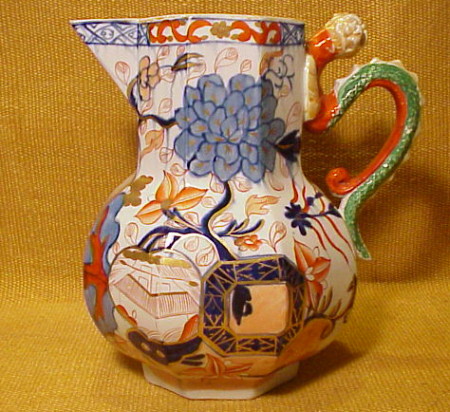Combine a big, bold, dynamic shape jug with a serpent handle just as bizarre as it is...
Combine a big, bold, dynamic shape jug with a serpent handle just as bizarre as it is bold, decorate it with a big scale version of Masons "Jardinere" pattern and you have this piece. The paneled shape of this jug creates so many sharp angles that it appears to have been assembled in slabs of clay. There is no question the serpent handle was molded separately and -- given the extra arch of the back and tilt of the head -- applied while still in pliable state. We know that at this period, the cobalt areas would have been fired separately from the balance of the pattern --and we assume the large blue mums as well, then all knitted together with the orange freehand decoration. This theory is certainly supported by the ideal placement of foliage, vines and blooms. The pattern is finished by coloring the sepent handle bright green and giving his head a wash of ochre luster -- as well as his spine and the lip of the jug. Finally a band of oriental fretwork, obviously executed freehand decorates the rim, inside and out in sections of blue and orange.
No one ever described Masons as a timid, over refined pottery. Nevertheless, an example comes around now and then that represents the boldest of the bold. This is a big bold jug; all angles, no flourishes; hardly even a foot. The spout is more like a chute. The decoration is executed on a large scale. There is no difficulty picking out the major elements of the rather abstract "Jardiniere" pattern: a cobalt block "o" form, a lighter blue chrysanthemum, and a vaguely heart-shaped reserve with a sketchy Asian building.























